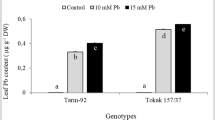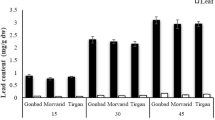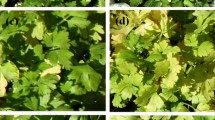Abstract
Toxic effects of lead (>0.2 mM Pb) were measured in pigeon pea (Cajanus cajan Mill) cv. UPAS grown in sand culture as reduction in growth, yield, and quality of seeds. Leaves containing >38 μg g−1 Pb showed oxidative damage as decrease in chlorophyll content and induction of antioxidants such as carotenoids, proline, and non-protein thiol contents with enhanced activities of SOD and peroxidase. At excess (>0.2 mM) Pb, accumulation of >1,000 μg Pb g−1 root tissue was associated with increase in non-protein thiol content. It is concluded that inhibition in root-to-shoot translocation of Pb and induction in the level of proline, chloroplast pigments, and non-protein thiols and activities of antioxidant enzymes SOD and peroxidase at <0.2 mM Pb could have protected the pigeon pea plants from the deleterious effects of Pb. However, excess Pb at >0.2 mM showed a decline in yield, boldness, and quality of seeds despite the expression of an additional band each of Cu–Zn SOD and peroxidase isoform. The threshold of toxicity and toxicity values in pigeon pea leaves of plants exhibiting 10 and 33% yield depression at 27 days after metal supply were 27 and 56 μg Pb g−1, respectively.






Similar content being viewed by others
References
Agarwala SC, Sharma CP (1976) Pot sand culture technique for the study of nutrient element deficiencies under Indian conditions. Geophytol 6:356–367
Allowy BJ (1992) Understanding Our Environment (2nd edn), Royal Society of Chemistry, Cambridge
Bartley GE, Scolnik’ PA (1995) Plant Carotenoids: Pigments for photoprotection, visual attraction, and human health. Plant Cell 7:1027–1038
Bates LS, Waldren RP, Tease ID (1973) Rapid determination of the proline for stress studies. Plant Soil 85:107–129
Beauchamp C, Fridovich I (1971) Superoxide dismutase: improved assays and an assay applicable to acrylamide gel. Anal Biochem 44:276–287
Cobbett CS (2000) Phytochelatin biosynthesis and function in heavy-metal detoxification. Curr Opin Plant Biol 3:211–216
Daniela MM, Nicole A, Septimiu M (2010) Studies regarding the Pb toxicity accumulation in plants. Romanian Biotechnological Letters 15:5240–5245
Ellman GL (1959) Tissue sulfhydryl groups. Arch. Biochem Biophys 82:70–77
Eun SO, Youn HS, Lee Y (2000) Lead disturbs microtubule organization in the root meristem of Zea mays. Physiol Plant 110:357–365
Gaitonde MK (1967) A spectrophotometric method for the direct determination of cysteine in the presence of other naturally occuring amino acids. Biochem J 104:627–633
Hernandez-Pinero JL, Maiti RK, Star J, Diaz G, Onhalez A, Avila ML, Orough-Bakhch R (2002) Effect of lead and cadmium on seedling growth chlorophyll and protein content of common bean (Phaseolus vulgaris), alfalfa (Medicago sativa), avena (Avena sativa) and rye grass (Lolium multiflorum) selected as hyperaccumulator of heavy metals. Res on Crops 3:473–480
Hewitt EJ (1966) Sand and Water Culture Methods Used in the Study of Plant Nutrition, Technical Communication No. 22. Commonwealth Agricultural Bureau, London
Kalembasa D, Malinowska E (2009) Influence of sewage sludge fertilization on heavy metal content in biomass of silvei during field experiment. J Plant Growth Regul 28:229–244
Laemmli UK (1970) Cleavage of structural proteins during the assembly of the head of bacteriophage T4. Nature 227:680–685
Lichtenthaler HK (1987) Chlorophylls and carotenoids: Pigments of photosynthetic biomembranes. In: Packer L, Douce R (eds) Methods in Enzymology. Academic Press, NewYork, pp 350–382
Lowry OH, Rosebrough NJ, Farr AL, Randall RJ (1951) Protein measurement with Folin-phenol reagent. J Biol Chem 193:265–275
Luck H (1963) Peroxidase. In: Bergmeyer HU (ed) Methods of Enzymatic Analysis. Academic Press, New York, pp 895–897
Malecka A, Jarmuskiewicz W, Tomaszewska B (2001) Antioxidative defence to lead stress in subcellular compartments of pea root cells. Acta Biochim Pol 48:687–698
Malecka A, Piechalak A, Morkunas I, Tomaszewska B (2008) Accumulation of lead in root cells of Pisum sativum. Acta Physiol Plant 30:629–637
Malkowski E, Kita A, Galas W, Karez W, Michael K (2002) Lead distribution in corn seedlings (Zea mays L.) and its effect on growth and the concentration of potassium and calcium. Plant Growth Regul 37:69–76
Mittler R (2002) Oxidative stress, antioxidants and stress tolerance. Trends Plant Sci 7:405–410
Passardi F, Cosio C, Penel C, Dunand C (2005) Peroxidases have more functions than a Swiss army knife. Plant Cell Rep 24:255–265
Rashid A, Camm EL, Ekramoddoullah KM (1994) Molecular mechanism of action of Pb and Zn2+ on water oxidizing complex of photosystem II. FEBS Lett 350:296–298
Romanowska E, Igamberdiev AU, Parys E, Gardeström P (2002) Stimulation of respiration by Pb in detached leaves and mitochondria of C3 and C4 plants. Physiol Plant 116:148–154
Romanowska E, Wroblewska B, Drozak A, Zienkiewicz M, Sidlecka M (2008) Effect of Pb ions on superoxide dismutase and catalase activities in leaves of pea plants grown in high and low irradiance. Biol Plant 2:80–86
Rudakova EV, Karakis KD, Sidorshina ET (1988) The role of plant cell walls in the uptake and accumulation of metal ions. Fiziol Biochim Kult Rast 20:3–12
Seregin IV, Ivanov VB (1997) Histochemical investigation of cadmium and lead distribution in plants. Fiziol Rast 44:915–921
Sharma P, Dubey RS (2005) Toxic metals in plants: Lead toxicity in plants. Braz J Plant Physiol 17:35–52
Sieghardt H (1988) Schwermetall- und Nahrelementgehalte von Pflazen und Bodenproben schwermetallhaltiger Halden im Raum Bleiberg in Karnten (Osterreich). II. Holzpflazen. Z Pflazenenernahr Bodenk 151:21–26
Singh RP, Tripathi RD, Sinha SK, Maheshwari R, Srivastava HS (1997) Response of higher plants to lead contaminated environment. Chemosphere 34:2467–2493
Sinha P, Dube BK, Srivastava P, Chatterjee C (2006) Alteration in uptake and translocation of essential nutrients in cabbage by excess lead. Chemosphere 65:651–656
Stefanov K, Seizova K, Popova I, Petkov VL, Kimenov G, Popov S (1995) Effects of lead ions on the phospholipid composition in leaves of Zea mays and Phaseolus vulgaris. J Plant Physiol 147:243–246
van Assche F, Clijsters H (1990) Effects of metal on enzyme activity in plants. Plant Cell Environ 13:195–206
Acknowledgments
The work is supported by the Indian Council of Agricultural Research under the All India Coordinated Research Project on “Micro and secondary nutrients and pollutant elements in soils and plants”.
Author information
Authors and Affiliations
Corresponding author
Additional information
Communicated by G. Bartosz.
Rights and permissions
About this article
Cite this article
Nautiyal, N., Sinha, P. Lead induced antioxidant defense system in pigeon pea and its impact on yield and quality of seeds. Acta Physiol Plant 34, 977–983 (2012). https://doi.org/10.1007/s11738-011-0894-6
Received:
Revised:
Accepted:
Published:
Issue Date:
DOI: https://doi.org/10.1007/s11738-011-0894-6




